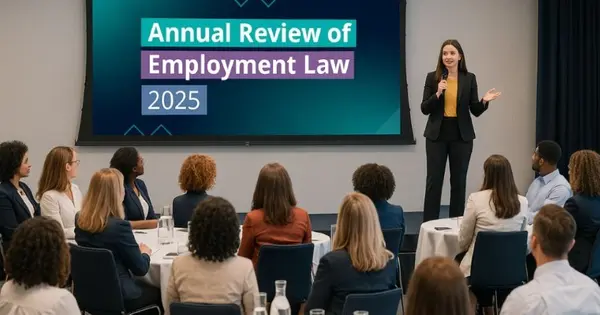Seamus McGranaghan qualified as a Solicitor in O'Reilly Stewart Solicitors in 2003 and is an experienced Commercial Lawyer dealing with employment, commercial and education cases.
He has experience in the Industrial Tribunal representing both Claimants and Respondents and has provided seminars in relation to particular areas of employment law. Seamus is the only member of the Education and Law Association in Northern Ireland. He specialises in advising schools and colleges on policy matters, employment issues and student welfare. He is also responsible for the Education Law Quarterly Review.
In addition to having contributed at Legal Island’s Education Updates since 2010, Seamus in association with Legal Island provides a live “Employment Law @ 11” webinar on the first Friday of each month, dealing with all aspects of Employment law affecting Northern Irish employers.
Concerns around redundancies here in NI in big names such as Norbrook, Ulster Bank and BT, and the collapse of household name Wilko in England have highlighted this uncomfortable reality for HR. Conducting the process well and legally can make all the difference for everyone concerned. Seamus McGranaghan, O'Reilly Stewart Solicitors, offers his tops tips and advice, including the advantages of a well-drafted Compromise Agreement.
Christine: Let's move on to redundancy, Seamus. This is something that you're dealing with day and daily really, and that's why we're talking about it. It is becoming, unfortunately, a reality for HR in Northern Ireland more and more. So, do you want to give us a bit of an intro into that?
Seamus: Well, I think it's interesting just taking that back to the poll there in relation to a third of the listeners that are currently looking at some sort of restructure. Now, that doesn't necessarily mean that there will be redundancies flowing out from that. But I suppose the starting point in relation to any possible redundancy process is always that aspect of planning work and looking at your staffing levels.
That is something that is encouraged and should happen within any organisation to make sure that there's sufficient work for the employees that are there and looking to see, "Do we need to increase our employees because we have new work coming in or there's a pipeline of work coming?" Or where there is the potential that there is a decrease in work, we might need to look at different options in relation to our staffing complement at that point.
Fundamentally, the employer should always be looking to avoid redundancies. So, it shouldn't be a fait accompli.
Redundancies in Northern Ireland, our process is slightly different to what it is over in England and Wales. So, if you're looking at redundancies, always go to sort of our local resources here in relation to that. It's always helpful to take legal advice in relation to it, of course. But we have great support through the Labour Relations Agency and the various guidance and advice that they have online in relation to dealing with redundancy.
Redundancy is never pleasant or an easy one to deal with, but certainly, at the minute, Christine, it seems to be that it is on the increase. And certainly, the poll highlights that.
In general, when it comes to redundancies, there's lots that you could say, and you could do a whole webinar on one aspect of redundancies. I mean, if you wanted just to look at consultation. But I think we're taking a sort of broad approach to it this morning and seeing if we have any specific questions that arise.
Generally, redundancies will come around three factors. We lawyers always refer to it as ETO, and it's the economic, trade, and organisation, those factors that will impact work and staffing levels associated with the work.
So, if you think back to whenever COVID arrived with us in March/April 2020, wide state of panic, phone ringing off the hook, "Need to make redundancies, need to make redundancies". And then, of course, government stepped in with assistance, and it was able to sort of reduce the impact that COVID was having on staff and on the possibility of redundancies.
So, look, your redundancy situation always has to be genuine. It's a definite warning for anybody that says, "I don't like this employee and I need rid of them and redundancy is the easiest way to do it".
I will get a lot of calls. I'm sure you did whenever you were in private practice as well. You'll get calls like that and you'll immediately get prickly and defensive about it and say, "No, no, no. You can't do that. You're going to end up in a difficult tribunal case if that's the process that you're going to take".
So, it should never be that sort of one-on-one, "We need to get rid of this employee, so we're just going to do a reorganisation so that we can kick that person out and make them redundant". That makes things tricky and difficult.
Various other things that you need to watch out for. Obviously, consultation is a really important point of any redundancy. And whether you're in an organisation that is unionised or is not unionised, there are different processes whenever there's a union involved.
But in general, you're looking at if you're making any more than 20 employees redundant within a 90-day period within one establishment as it is, then you need to do what's called collective consultation in respect of redundancies. It needs to be reported through to the Northern Ireland Statistics board, and there are various steps that have to be taken in relation to it. So, it's important that you do get legal advice if you're going down this process.
Look, that's a really good comment from the trade union official there. I always take the approach the trade union is not there to fight or punish or battle with the employer. The trade union is there . . . If you look at any of the consultation and documentation from Labour Relations Agency, and don't forget that that's a statutory process, the trade union is there to provide assistance.
The employer should be doing their best to avoid redundancies, and the trade union is there to assist the employer in doing that.
Where that's not possible, the trade union is there to try to reduce the volume of redundancies or reduce the number of redundancies and also make sure that there's a proper process that is put in place.
And if you're doing large-scale redundancies, your job tends to be easier whenever you get on board and you liaise and work with the trade union rather than battle against them. That's my experience. So, I would agree with that comment that was made.
The other really important key aspect with the with redundancies is that you must remember that you are dealing with potential dismissals and you must follow the three-stage statutory procedure that follows with the 2003 Employment (Northern Ireland) Order and the Dispute Resolution Regulations of 2004.
If you don't follow that process, and if you fall down on any of the three-stage procedures, it's going to be an automatic unfair dismissal. So that's key.
And obviously, you need to make sure that you're properly consulting with your employees, because if you don't and there's a failure to do that, protective awards can be provided by the tribunal as well.
What surprises me all the time is that whenever I get a call from an employer about redundancies, they don't have a redundancy policy and procedure in place, and there's nothing to work from. Or sometimes they'll have a two-page document.
If you're doing large-scale redundancies, again, it is about engaging with the trade union, if there is, or with the employee representatives alternatively. It's about trying to get a redundancy policy and procedure agreed.
And that should also factor in what your selection criteria might look like as well in terms of trying to get that agreed so that everybody is clear what the process is going to be and how it's going to . . . what the outworkings of the process are going to be.
Sometimes it ends up that you are consulting individually where a trade union isn't involved, and that is a real important point. Certainly, whenever the legislation changed in and around 2004, whenever the regulations were brought in after that, lots of people fell down in relation to the failure to . . . whether they didn't meet, whether it wasn't in writing, whether or not they didn't hold the meeting, and whether they didn't then ultimately provide for an appeal always causes some difficulties.
I would still see decisions arising whereby there are issues that arise around appeals that aren't facilitated, and there's a determination then that the three-stage procedure wasn't followed. And then you see an increase in the compensatory award that's happening. That's one of the powers of the tribunal, obviously.
So, through that consultation process, you are looking at trying to avoid redundancies, reduce the number of employees being made redundant, or reducing the effects of redundancies themselves.
When it comes to your selection criteria, your selection criteria should be unbiased, it should be fair, and it should be consistent. It shouldn't be discriminatory, and certainly it shouldn't leave a group or an employee feeling, "I've been targeted specifically by these criteria, and I'm out the door because of the way that this has been drafted".
I did one recently where I assisted an employee, and it very much felt like that. And when we picked it and unravelled it, it was clear that this employee was being targeted because that was the employee that the employer wanted to go.
We asked for copies of the minutes of the determination meeting, of the scoring, of all of the discussions that took place during that process. And the employer wasn't able to produce any of that.
What resulted was that we were able to work through a process where we were able to . . . By this stage, the employee no longer wanted to work for the employer. And we were able to look at a sort of fair exit package for the employee as well.
So, you need to be very careful about your selection criteria, and there's lots of guidance out there about it. So, one of the most . . .
Christine: Sorry, Seamus.
Seamus: Yes.
Christine: I just want to jump in because there's a question that relates directly to selection criteria, and I think that would fit in here. So, should selection criteria not be excluded from any redundancy policy and agreed on a case-by-case basis, as every redundancy situation is presumably different? I think I would tend to agree with that. What about you, Seamus?
Seamus: Yeah. I mean, I think that most redundancy policies and procedures will give a flavour of the type of criteria that can be used. But if you're applying criteria to a certain group, chances are that you will need to make sure that the criteria is fair and workable and manageable.
The idea of the criteria, of course, is to come away from the selection process retaining the best employees that you have for moving the business forward, essentially. So, the criteria need to be able to get you where you need to go. It has to be criteria that will get you an end result, but it does need to be fair criteria.
And at times, you might say, "Look, listen, those five categories, none of them have a disciplinary, none of them are late, and they all did well in their appraisals. So, how are we going to move this to get a goal?" You will need to do that.
But the important point is that when you are putting your criteria together, you're making sure that you're consulting in relation to that process as well.
Christine: Yeah. And what about a compromise agreement, Seamus? When would that be appropriate to use? If you're fairly confident, you've followed your three-stage criteria, you've consulted with everyone concerned, you've had the unions in, why would you need a compromise agreement then?
Seamus: Well, I would say a lot of compromise or settlement agreements coming across my desk, and even as a practitioner where you are very confident that your client has followed a fair procedure in respect of the redundancy, there's always risk that the employee will decide that they're going to take a claim against the employer. There's always risk of that.
And often with redundancy procedures, it is personal to the employee. And often, the employee just doesn't accept that there's been a fair process that has been applied. So, there's always a risk of a claim.
I would say a lot of employers, although they may be content and happy that they've completed a fair and robust procedure, they want to minimise the risk or the costs of claims that arise.
And what they will do is they will enhance the redundancy package that has been on offer. So, they'll maybe look at the statutory package or whatever the contractual package is, and then look to enhance it on the basis that it would be subject to the employee entering into some sort of agreement.
And whether that's through a non-ET1 agreement via the Labour Relations Agency or through a compromise agreement here in Northern Ireland, the key thing for compromise agreements is that they're only legally binding if the employee obtains independent legal advice from a legal adviser, and that that legal adviser signs a certificate to say that they've provided independent legal advice.
Otherwise, if the employee signs an agreement and sends it back to an employer, it doesn't have any weight and it wouldn't preclude an employee from subsequently bringing a claim against the employer.
So, look, a lot of employment lawyers will from time to time deal with compromise agreements, and you will see them through where there are larger-scale redundancies.
And again, through negotiation and consultation with the trade union at times. That is something that can be negotiated. And ultimately, then, the employee has to obtain independent legal advice to ensure that they have been properly advised before they make a decision to sign an agreement.
Christine: Brilliant. Thanks very much, Seamus. I'm just very mindful of the time. I'm going to do my takeaways and wrap this portion up.
So, my personal takeaways are, firstly, when managing redundancies here in Northern Ireland, adhere to the statutory consultation requirements. That's first and foremost.
Secondly, ensure your selection criteria are fair and non-discriminatory, and consider alternative options such as redeployment or retraining to minimise that impact on employees.
And thirdly, a well-drafted compromise agreement can make all the difference, so do consider that.
Legal Island Training Resources for Your Staff
HR Toolkit | eLearning Course
Are you responsible for overseeing the implementation of training for all employees in your organisation?
Legal Island has created an HR Toolkit that aims to provide comprehensive training to assist HR professionals in supporting line managers and employees throughout the employee journey. The suite of courses will offer practical advice to assist you in updating your processes and procedures and help you understand your legal obligations.
Click here to view our HR toolkit.
Continue reading
We help hundreds of people like you understand how the latest changes in employment law impact your business.
Please log in to view the full article.
What you'll get:
- Help understand the ramifications of each important case from NI, GB and Europe
- Ensure your organisation's policies and procedures are fully compliant with NI law
- 24/7 access to all the content in the Legal Island Vault for research case law and HR issues
- Receive free preliminary advice on workplace issues from the employment team
Already a subscriber? Log in now or start a free trial



